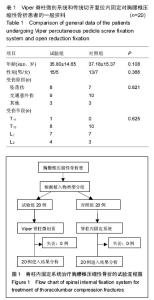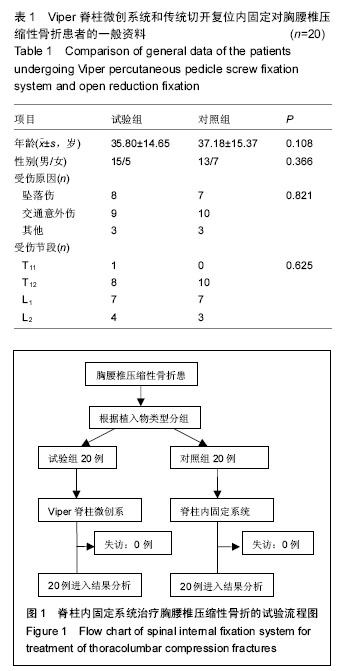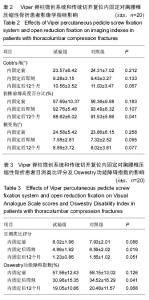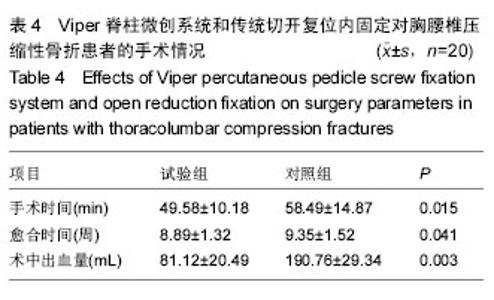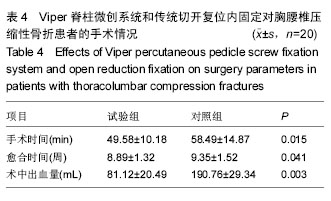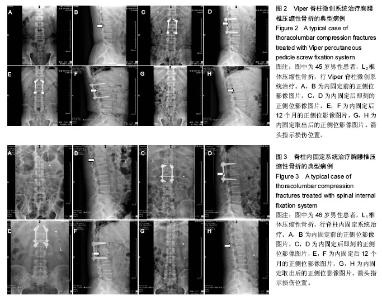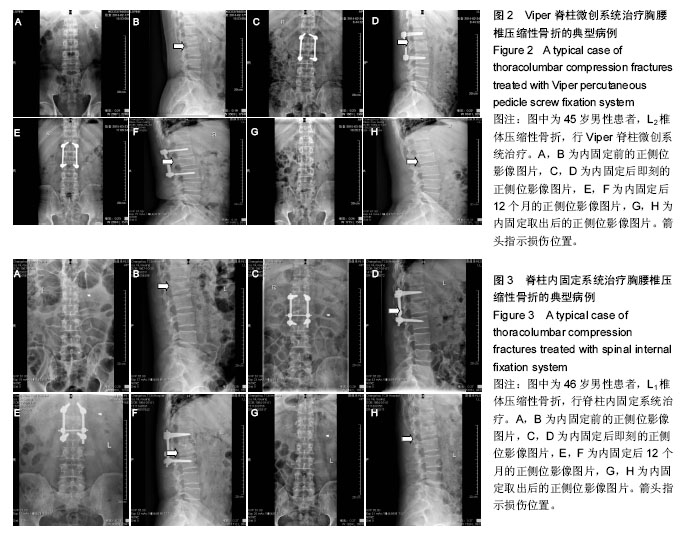| [1] Gnanenthiran SR, Adie S, Harris IA. Nonoperative versus operative treatment for thoracolumbar burst fractures without neurologic deficit: a meta-analysis. Clin Orthop Relat Res. 2012;470(2):567-577.
[2] 董学亮,倪飞,张政宏,等.胸腰椎压缩性骨折保守治疗同PKP术治疗的比较[J].中国中医骨伤科杂志,2016(2): 29-32.
[3] 齐保军,朱帆,武忠炎.胸腰椎体骨折治疗的研究进展[J].医学综述,2016,22(6):1128-1132.
[4] 李智斐,钟远鸣,周宾宾,等.单纯胸腰椎压缩性骨折保守治疗研究进展[J].广西中医药大学学报,2006,9(4):87-90.
[5] Shimer AL, Su BW. Operative versus Nonoperative treatment of thoracolumbar bumt fractures. Semin Spine Surg. 2010;22(1):38-43.
[6] 唐刚,江建明,瞿东滨,等.后路经伤椎椎弓根固定在胸腰椎骨折治疗中的应用[J].中国骨与关节损伤杂志,2010, 25(3):228-229.
[7] 陈可夫.胸腰椎爆裂性骨折外科干预方式选择的研究进展[J].中国矫形外科杂志,2015,23(2):132-135.
[8] Gaines RW Jr. The use of pedicle-screw internal fixation for the operative treatment of spinal disorders. J Bone Joint Surg Am. 2000;82-A(10):1458-1476.
[9] 胡正霞,李开南,何智勇.改良多裂肌间隙与传统后正中入路椎弓根螺钉置入修复胸腰椎骨折:伤椎稳定性及相关指标比较[J].中国组织工程研究,2015,19(4):544-547.
[10] Vaccam AR, Bono CM. Minimally Invasive Spine Surgery. USA: Informa Health Care Inc, 2009: 5-9.
[11] Wang HW, Li CQ, Zhou Y, et al. Percutaneous pedicle screw fixation through the pedicle of fractured vertebra in the treatment of type A thoracolumbar fractures using Sextant system: an analysis of 38 cases. Chin J Traumatol. 2010;13(3):137-145.
[12] 贺瑞,童元.直视下微创椎弓根螺钉内固定的解剖学观察和临床应用[J].安徽医科大学学报,2007,42(2):202-204.
[13] 张文志,尚希福,段丽群,等.微创经皮与传统开放椎弓根螺钉内固定治疗胸腰椎骨折的临床对比研究[J].中国骨与关节外科,2012,5(2):106-111.
[14] 邱铃芳,陈卫,王波,等.反向预弯钛棒在单节段胸腰椎压缩性骨折治疗中的应用[J].骨科, 2016(1):35-39.
[15] 翟数超,鲁世宝.胸腰椎骨折的分类系统及手术治疗研究进展[J].实用骨科杂志,2014(10):914-917.
[16] 崔新刚,张佐伦,王道军,等.腰椎三种椎弓根定位方法的对比解剖学研究[J].中国脊柱脊髓杂志,2005,15(7): 433-435.
[17] 陈睿,宋恒平,倪凤民.下段胸椎椎弓根钉道入路手法的选择[J].中国骨与关节损伤杂志,2014(S1):106-107.
[18] 管宏新,朱晋,仲骏,等.微创治疗胸腰椎压缩性骨折的疗效分析[J].上海交通大学学报(医学版),2010,30(10): 1258-1262.
[19] 何家维,严志汉,虞志康,等.PACS工作站上Cobb角测量的可靠性研究[J].中国脊柱脊髓杂志,2006,16(10): 732-734.
[20] 郑安华,徐正生,方崇斌.椎弓根螺钉固定联合与非联合伤椎置钉治疗单节段胸腰椎骨折的对比研究[J].中医正骨, 2012,24(12):20-22.
[21] Stubbs DF. Visual analogue scales. Br J Clin Pharmacol. 1979;7(1):124.
[22] 郑光新,赵晓鸥,刘广林,等.Oswestry功能障碍指数评定腰痛患者的可信性[J].中国脊柱脊髓杂志,2002,12(1): 13-15.
[23] Hebert JJ, Marcus RL, Koppenhaver SL, et al. Postoperative rehabilitation following lumbar discectomy with quantification of trunk muscle morphology and function: a case report and review of the literature. J Orthop Sports Phys Ther. 2010;40(7): 402-412.
[24] 李智斐,钟远鸣,周宾宾,等.单纯胸腰椎压缩性骨折保守治疗研究进展[J].广西中医学院学报,2006,9(4):87-90.
[25] German JW, Foley KT. Minimal access surgical techniques in the management of the painful lumbar motion segment. Spine (Phila Pa 1976). 2005;30 (16 Suppl):S52-59.
[26] Palmisani M, Gasbarrini A, Brodano GB, et al. Minimally invasive percutaneous fixation in the treatment of thoracic and lumbar spine fractures. Eur Spine J. 2009;18 Suppl 1:71-74.
[27] 荣树,马兆钦,吴峥,等.改良微创椎弓根钉固定治疗胸腰段骨折[J].生物骨科材料与临床研究,2013,10(5):28-31.
[28] 李涛,李伟,牛占岭,等.微创经皮椎弓根置钉内固定治疗胸腰椎压缩性骨折[J].中国骨与关节损伤杂志,2013,28(11): 1065-1066.
[29] 陈曦,孙旭,陈忠辉,等.胸腰椎压缩性骨折椎间盘形态学观察及临床意义[J].东南大学学报(医学版),2016,35(2): 176-180.
[30] 尹东,郑晓青,梁昌详,等.应用Viper 和Pipeline 微创系统治疗腰椎退行性疾病[J].中国矫形外科杂志,2014,22(1): 28-31.
[31] Park Y, Ha JW, Lee YT, et al. Cranial facet joint violations by percutaneously placed pedicle screws adjacent to a minimally invasive lumbar spinal fusion. Spine J. 2011;11(4):295-302.
[32] 张强,纪玉清,胡樵,等.胸腰椎骨折后路微创器械的设计及临床应用[J].中华创伤骨科杂志,2010,12(7):605-608.
[33] 杨雷,李家顺,贾连顺,等.经皮椎弓根螺钉技术的解剖学基础及其临床意义[J].中国临床解剖学杂志,2004,22(1): 58-62.
[34] 陈宣煌,许卫红,胡建伟,等.小切口椎旁肌间隙入路和传统开放式入路腰椎后路融合术的比较[J].脊柱外科杂志, 2012,10(2):101-104.
[35] 周成文,牟永山,马惠章,等.微创经皮椎弓根钉固定治疗胸腰椎压缩性骨折[J].实用骨科杂志,2011,17(11): 1023-1025.
[36] 连保卫,黎建文,朱爱剑,等.微创经皮椎弓根钉固定非融合技术治疗胸腰椎压缩性骨折35例临床观察[J].医学临床研究,2014,31(2):369-370.
[37] 许财元,张涛,高中玉,等.短节段椎弓根钉内固定治疗胸腰椎骨折——经伤椎与跨伤椎的临床疗效比较[J].天津医科大学学报,2016(1):58-61.
[38] 王秀会,朱汉光,吴祖民,等.经皮微创相邻节段椎弓根钉植入治疗单节段胸腰椎脊柱骨折[J].中国微创外科杂志, 2010,10(9):785-787.
[39] 倪文飞,尹丽慧,池永龙,等.经皮与开放手术治疗胸腰椎骨折术中椎旁肌细胞应激反应的比较研究[J].浙江创伤外科,2008,13(1):6-8. |
